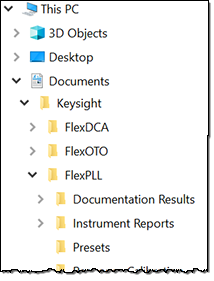:CALibrate Response Commands
The response calibration that normalizes any linear effects in the source jitter signal creation, the cabling and interconnects, and the response measurement. Once performed, you can save the response calibration to disk and recall the calibration for later use. However, a recalled calibration must be applied to the same hardware setup that was used to create the original calibration file.
Always perform a module calibration before performing a Response calibration.
When you start a Response calibration, the test setup should be similar to that shown in the following figure. You can use either a DCA-X mainframe or a DCA-M module, as shown in this diagram. An adapter is used in place of where your DUT would normally be connected.

During the calibration, FlexPLL prompts you to replace the adapter with your DUT.


Each time that a Response Calibration is performed, FlexPLL automatically saves a calibration file (*.jtfx) in the FlexPLL's \Response Calibration folder:
C:\Users\user-name\Documents\Keysight\FlexPLL\Response Calibration
A Response Calibration is valid only when both of the following current conditions are true:
- Test setup hardware matches the hardware used at the time that the calibration was created.
- Source and Receiver settings match the settings used at the time that the calibration was created. If the settings match for the current calibration, the Load Source Settings and Load CDR Settings are not active (grayed out) and the calibration is valid. If the settings do not match, these buttons are active, and you can click them to copy the settings from the calibration file to the dialogs.
During a Response Calibration, the only Receiver Setup dialog setting that is used is the Clock Recovery's Source input connector (:CRECovery:SOURce command). During a calibration, FlexPLL automatically sets the Clock Recovery's Symbol Rate to double the Source's Jitter Clock Rate. This is because the JTF source is connected directly to the JTF receiver. An adapter replaces the DUT. In this situation, the receiver's CDR does not need to be locked.
Recommended Calibration Conditions
A calibration is recommended whenever any of the following conditions are true:
- The hardware setup has changed
- Receiver's power has been cycled
- Module has been removed and then reinserted since the last calibration
- DCA-X temperature change exceeds 5°C compared to the temperature of the last module calibration ( ΔT > 5°C)
- Time since the last calibration has exceeded 10 hours